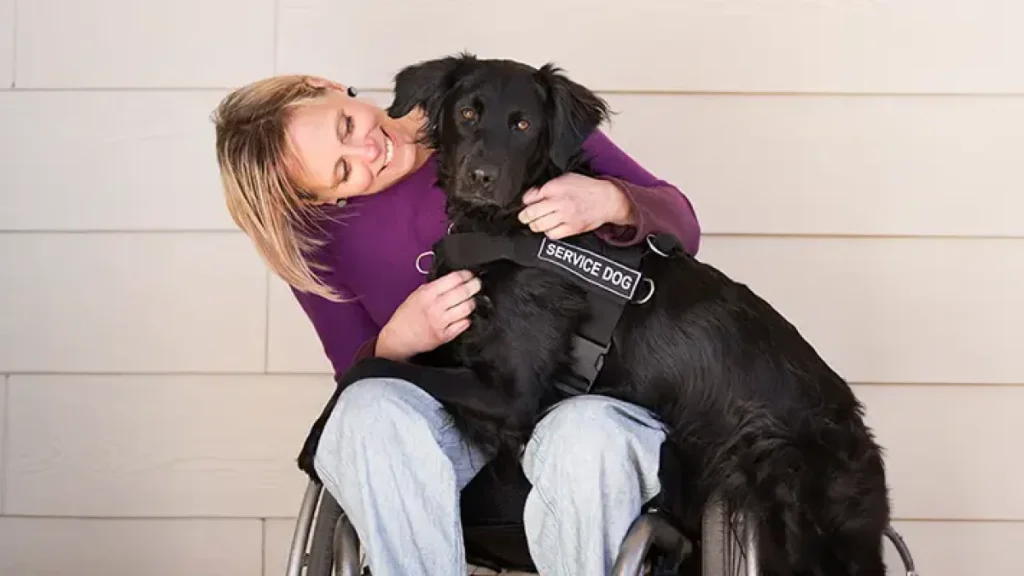Dog Training for Therapy: Preparing Animals for Emotional Support

The Healing Power of Canine Companionship
The bond between humans and dogs is a profound one, transcending mere companionship. Therapy dogs offer emotional support that can improve mental health and enhance overall well-being. These unique animals not only provide comfort but also serve as everyday heroes in various sectors such as healthcare, education, and rehabilitation. Understanding how to effectively train these dogs is crucial for maximizing their positive impact, transforming them into skilled companions that make a real difference in people’s lives.
Training therapy dogs involves a multifaceted approach that goes beyond traditional obedience training. It requires an emphasis on their ability to interact appropriately with individuals in different settings. Consider the following key aspects of therapy dog training:
- Socialization: Dogs must be comfortable around different people and environments. This includes exposure to various sounds, sights, and situations such as bustling hospital corridors or animated classrooms. Proper socialization helps dogs become well-adjusted and minimizes anxiety or fear in new situations.
- Basic Commands: Consistent responses to commands like sit, stay, and come are essential. A therapy dog must be able to follow instructions reliably, which ensures safety and control during interactions with patients or students. This foundation also builds the dog’s confidence in their role.
- Calm Demeanor: Therapy dogs must display calmness in potentially stressful situations. They often encounter individuals who may be fearful, anxious, or in pain. A calm presence helps soothe and stabilize the emotional state of those in need, providing a sense of reassurance.
- Empathy Training: Understanding human emotions is a unique skill that enhances their effectiveness. Through specialized training, therapy dogs learn to respond to a range of human feelings, such as sadness or anxiety, allowing them to provide comfort effectively and intuitively.
In the United States, therapy dogs are increasingly utilized in a variety of settings including hospitals, schools, and rehabilitation centers. Studies have shown that the presence of these trained animals often leads to decreased feelings of anxiety and increased emotional connection among those they serve. For instance, a therapy dog might work with children struggling with learning disabilities, helping them feel more at ease and improving their academic engagement.
As we delve into the intricacies of dog training for therapy, we will explore various methodologies and best practices that help prepare these animals for their vital roles in emotional support. Techniques such as positive reinforcement, desensitization, and structured social interactions are some of the innovative strategies being employed today to train therapy dogs. Understanding and implementing these practices not only prepares dogs for their work but also fosters transformative experiences for both the animals and the individuals they assist.
The journey of training a therapy dog is not just about teaching commands and behaviors; it’s about cultivating a compassionate bond that enriches lives. As the world becomes more aware of mental health challenges, the role of therapy dogs will likely continue to grow, embracing the potential for canine companionship to provide healing in our communities.

DISCOVER MORE: Click here to learn about effective training methods
Essential Training Components for Therapy Dogs
To effectively prepare dogs for their therapeutic roles, trainers must implement a comprehensive training program that encompasses a variety of essential skills and attributes. The journey toward becoming a therapy dog is not solely about learning commands; it involves creating an emotionally intelligent animal capable of providing support and comfort under a broad range of circumstances. Here are several critical dimensions of therapy dog training that help ensure success:
- Positive Reinforcement: One of the cornerstones of dog training, positive reinforcement encourages desirable behaviors through rewards. Using treats, praise, or play as rewards helps dogs associate good behavior with positive outcomes. This method fosters a trusting relationship between the dog and handler, which is vital for effective therapy work.
- Desensitization Techniques: Therapy dogs often encounter stimuli that may be overwhelming or unfamiliar. Effective desensitization training involves gradually introducing dogs to these stimuli in controlled environments, helping them learn to remain calm and composed. Techniques such as allowing a dog to experience the sounds of a bustling hospital environment or interacting with children in a classroom can significantly reduce anxiety during real therapy sessions.
- Controlled Exposures: Regular exposure to different environments is crucial. Dogs should be taken to varied locations such as parks, malls, and schools to practice their training in public settings. Controlled exposures help dogs learn to adapt their behavior and reaction in the presence of distractions, making them more effective in real-life situations.
- Assessment of Temperament: Not every dog is suited for therapy work. Evaluating a dog’s temperament is vital to determine whether they possess the characteristics needed, such as friendliness, patience, and sociability. Dogs that exhibit eagerness to engage with people and demonstrate calmness in stressful scenarios are often best suited for therapy roles.
Moreover, the importance of handler-dog collaboration cannot be overstated. The bond between the trainer and the dog significantly influences training outcomes. Effective communication and mutual understanding between the animal and handler ensure a seamless connection during therapy sessions, ultimately enhancing the experience for both parties involved.
In various research studies, the efficacy of therapy dogs in reducing stress and anxiety levels has been documented. For instance, hospitals that incorporate therapy dog programs report improved patient outcomes, including reduced pain perception and enhanced emotional states. This growing body of evidence supports the ongoing need for structured training programs aimed at preparing dogs for these crucial roles in healthcare and beyond.
As therapy dogs continue to gain recognition for their invaluable contributions, dedicated pathways for comprehensive training remain essential. The methodologies employed not only enhance the skill sets of therapy dogs but also lay the foundation for transformative experiences that can uplift and reassure those who engage with them. By investing in their preparation, we ensure that these dogs fulfill their potential as compassionate companions, profoundly impacting the emotional lives of individuals they support.
| Advantages | Key Features |
|---|---|
| Enhanced Emotional Connection | Dogs trained for therapy provide a deep emotional bond, helping individuals feel understood and supported. |
| Stress Reduction | Interactions with therapy dogs have been shown to lower stress levels, making therapy sessions more effective. |
| Socialization and Communication Skills | Therapy dogs help patients improve their communication and social skills by encouraging interaction in a safe environment. |
| Physical and Mental Health Benefits | Regular sessions with therapy animals contribute to better physical health conditions and enhance mental well-being. |
When exploring the realm of Dog Training for Therapy, it’s essential to note how therapy animals are selected and trained. These dogs undergo specialized training to equip them with skills that facilitate emotional support for individuals in various settings, from hospitals to schools. They are not only trained to bond with humans but also to exhibit calmness and patience in challenging circumstances. This unique training allows them to navigate diverse emotional landscapes effectively, making them invaluable assets in therapeutic practices.Additionally, the rise of therapy dogs in mental health treatment is being recognized for decreasing symptoms of anxiety and depression, showcasing their profound impact in fostering emotional resilience. As society becomes increasingly aware of the benefits these trained animals offer, further research continues to validate and expand on their roles in emotional support.
DISCOVER MORE: Click here to learn about balanced nutrition
Integration of Specialized Training Techniques
In addition to the foundational skills outlined above, therapy dog training benefits from a range of specialized techniques geared toward enhancing an animal’s ability to provide emotional support. These training methods focus not only on obedience but also on advancing the dog’s cognitive abilities and nurturing their emotional sensitivity, fundamental attributes in therapeutic settings.
- Socialization Skills: Throughout their training, therapy dogs should undergo extensive socialization with various breeds, people, and environments. This exposure helps foster a dog’s ability to engage in positive interactions, making them more approachable and reassuring to those they will be comforting. For instance, introducing therapy dogs to diverse populations—including those with disabilities, older adults, and children—can refine their ability to recognize and respond to different emotional needs.
- Task-Specific Training: Dogs can be trained for specific therapeutic tasks depending on the needs of the populations they will serve. For example, some dogs may be trained to perform deep-pressure therapy, where they apply their weight on a person to help alleviate anxiety or panic attacks. Others might be trained to recognize when their handler is distressed and respond accordingly, offering comfort through gentle nudging or by positioning themselves close to the person.
- Calming Signals and Body Language: Understanding canine body language is vital, both for trainers and handlers. Therapy dogs should be trained to respond to cues indicative of distress or discomfort from clients. Similarly, therapy handlers can learn to interpret canine signals, promoting a harmonious and responsive interaction during therapy sessions. This mutual understanding enhances the emotional support experience and fosters a trusting relationship.
The role of professional oversight cannot be neglected. Trainers often collaborate with mental health professionals to tailor training programs that align with therapeutic goals. This interdisciplinary approach facilitates a deeper understanding of emotional needs and enhances the efficiency of therapy sessions. Programs integrating licensed therapists knowledgeable in animal-assisted therapy create frameworks that prioritize safety, effectiveness, and emotional well-being.
Moreover, ongoing evaluation is critical in maintaining the dog’s effectiveness as a therapy animal. Regular assessments ensure that a therapy dog’s behavior remains appropriate for their role. Through monitoring, trainers can identify any shifts in a dog’s temperament or reaction to different stimuli, allowing them to adjust training methods accordingly. For instance, if a therapy dog displays signs of stress during sessions, retraining or additional socialization might be necessary to avoid negatively impacting both the dog and clients.
As therapy dog programs expand across settings—from hospitals to schools—the role of individualized training plans increases in significance. Recognizing that each therapy dog has unique strengths and areas for growth allows trainers to create customized approaches that maximize therapeutic efficacy. By harnessing the individuality of each animal within a consistent training framework, trainers can prepare highly specialized support systems that enhance emotional recovery and well-being for those in need.
Through the integration of diverse training components and a focus on tailored approaches, dog training for therapy continues to evolve, highlighting the transformative impact that well-prepared animals can have on emotional support in our communities.
LEARN MORE: Click here to discover the importance of nutrition for your dog
Conclusion
In closing, the journey of dog training for therapy is both intricate and rewarding, as it lays the foundation for animals to provide indispensable emotional support to those in need. By combining essential obedience skills with specialized techniques, trainers focus on cultivating sensitive, intelligent, and responsive therapy dogs capable of navigating diverse environments and emotional landscapes. This preparation not only equips these animals to serve in healing capacities but also enhances the overall therapeutic experience for clients.
As therapy dog programs continue to flourish in settings like hospitals, schools, and rehabilitation centers across the United States, the emphasis on individualized training plans will further transform the landscape of emotional support. Understanding the unique characteristics of each dog allows trainers to create tailored strategies that address specific client needs, maximizing the impact of therapy sessions.
The collaborative approach involving trainers and mental health professionals ensures that therapy dogs are not only effective but also safe and supportive companions. As we continue to explore the profound benefits these animals offer in emotional recovery, it is essential to advocate for ongoing education and advancement in canine-assisted therapy methodologies. The potential for therapy dogs to uplift lives is limitless, and by investing in their training, we unlock a powerful tool for enhancing well-being in our communities.
Ultimately, as we witness the evolving role of therapy dogs, we are reminded that behind every successful interaction lies the training, dedication, and commitment to fostering genuine connections between humans and their four-legged allies. A well-prepared therapy dog has the power to heal, comfort, and enrich lives, proving that the bond between humans and animals can indeed create a profound impact.


